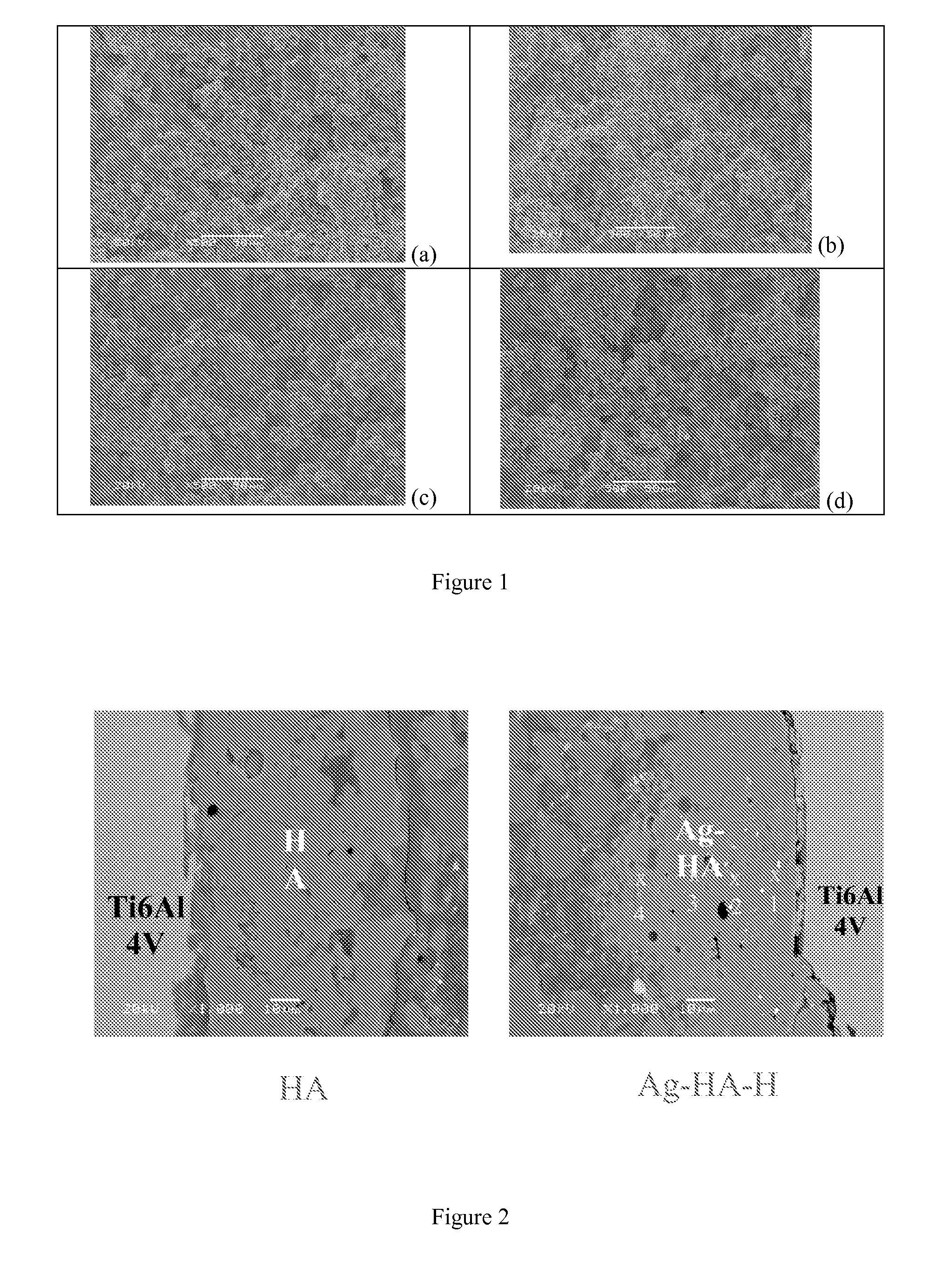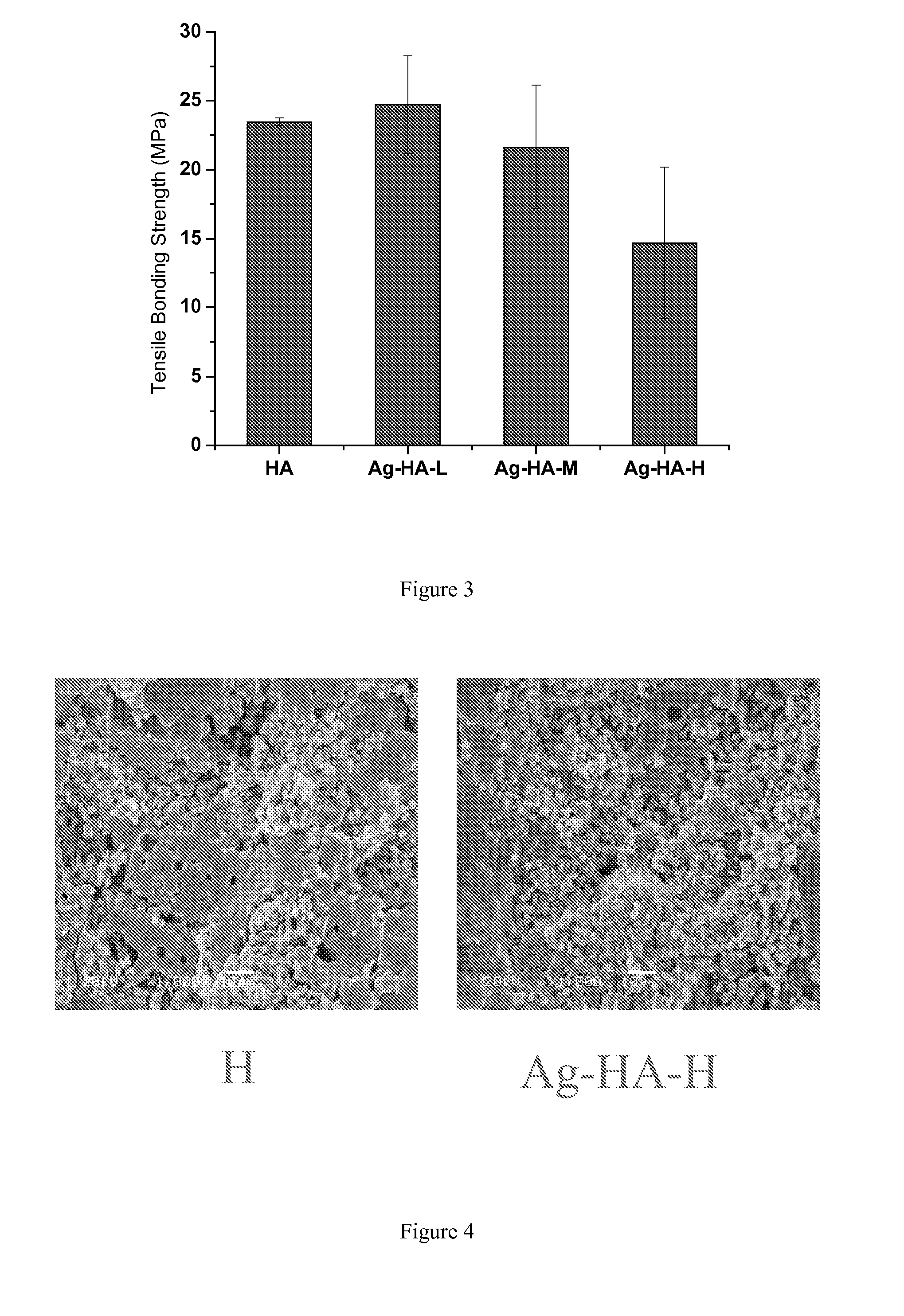Coating and coating method
a coating method and technology of coatings, applied in the field of coating methods, can solve the problems of infection at the implantation site, common infection at the host site, blood loss and thrombosis, etc., and achieve the effect of promoting osseointegration and reducing or eliminating the risk of infection
- Summary
- Abstract
- Description
- Claims
- Application Information
AI Technical Summary
Benefits of technology
Problems solved by technology
Method used
Image
Examples
example 1
Methods
[0142]Three different concentrations of silver nitrate solutions were prepared in distilled and de-ionized water (DDH2O) for the ion exchange reaction between silver nitrate solution and HA powders. Some Ag ions from the silver nitrate solution will substitute Ca ions from the HA structure, meanwhile, some silver compounds will be physically adsorbed on the HA surface. The target silver content in the HA powders was 0.3 wt %, 1 wt %, and 3 wt %, respectively. The mass of the silver nitrate and the HA powder was listed in Table 1.
[0143]
TABLE 1The mass of silver nitrate and HA powder used for the ion exchange reactionTarget AgAgNO3HADDH2Owt %Pure HA—250 g—0Ag-HA-L1.25 g250 g 750 mL0.3Ag-HA-M 4.0 g250 g1500 mL1.0Ag-HA-H12.0 g250 g3000 mL3.0
[0144]Silver nitrate (BDH, Cat.# BDH0276-125G) was first dissolved in DDH2O contained within a 3 liter glass beaker, and then the HA powders (MEDIPURE®, MEDICOAT AG, particle size: −125 μm+45 μm) were added into the prepared silver nitrate sol...
example 2
Hydroxyapatite Powder Modification Using Silver Nitrate Solution
[0173]Two different concentrations of silver nitrate solutions were prepared in distilled and de-ionized water (DDH2O) for the ion exchange reaction between silver nitrate solution and HA powders. In theory, some Ag ions from the silver nitrate solution will substitute Ca ions from the HA structure, meanwhile, some Ag ions will be physically adsorbed on the HA surface. The target silver content in the HA powders was 1 wt % and 2 wt %, respectively. The mass of the silver nitrate and the HA powder was listed in Table 8.
[0174]
TABLE 8The mass of silver nitrate and HA powder used for the ion exchange reactionTarget AgAgNO3HADDH2Owt %HA—250 g—0Ag-HA14.0 g250 g1500 mL1.0Ag-HA28.0 g250 g3000 mL2.0
[0175]Silver nitrate (BDH, Cat.# BDH0276-125G) was first dissolved in DDH2O contained within a 3 liter glass beaker, and then the HA powders (MEDIPURE®, MEDICOAT AG, particle size: −130 μm+45 μm) were added into the prepared silver ni...
example 3
Gradient Coatings for Biomedical Applications
[0215]FIG. 19 shows an example of an embodiment of the present invention (an implant substrate (1510) [e.g. Ti6Al4V] with a gradient coating containing VPS HA (1512) and VPS AgHA (1514). and a top layer of PLGA coating contains β-TCP, Ag, and Bupivacaine (1516)) prepared by the following method:
[0216]1. HA / Ag-HA Coating Preparation:
[0217]The Ag-HA powders (45-125 μm) were modified using an ion exchange reaction. The coating process parameters were the same as the standard vacuum plasma sprayed HA coatings produced at our manufacturing facility for medical implants. VPS HA coating was first applied and then followed by the VPS Ag-HA coating. The coated sample was ready for the PLGA coating.
[0218]2. Silver Modified β-TCP Powder Preparation:
1). 0.5 g β-TCP powder (D50˜3 μm) and 145.8 mg silver nitrate were dissolved into 55 mL de-ionized and distilled water and stirred for 1 hour at 60° C.
2). The water was evaporated overnight at 60° C.
3). T...
PUM
| Property | Measurement | Unit |
|---|---|---|
| thickness | aaaaa | aaaaa |
| thickness | aaaaa | aaaaa |
| thickness | aaaaa | aaaaa |
Abstract
Description
Claims
Application Information
 Login to View More
Login to View More - R&D
- Intellectual Property
- Life Sciences
- Materials
- Tech Scout
- Unparalleled Data Quality
- Higher Quality Content
- 60% Fewer Hallucinations
Browse by: Latest US Patents, China's latest patents, Technical Efficacy Thesaurus, Application Domain, Technology Topic, Popular Technical Reports.
© 2025 PatSnap. All rights reserved.Legal|Privacy policy|Modern Slavery Act Transparency Statement|Sitemap|About US| Contact US: help@patsnap.com



